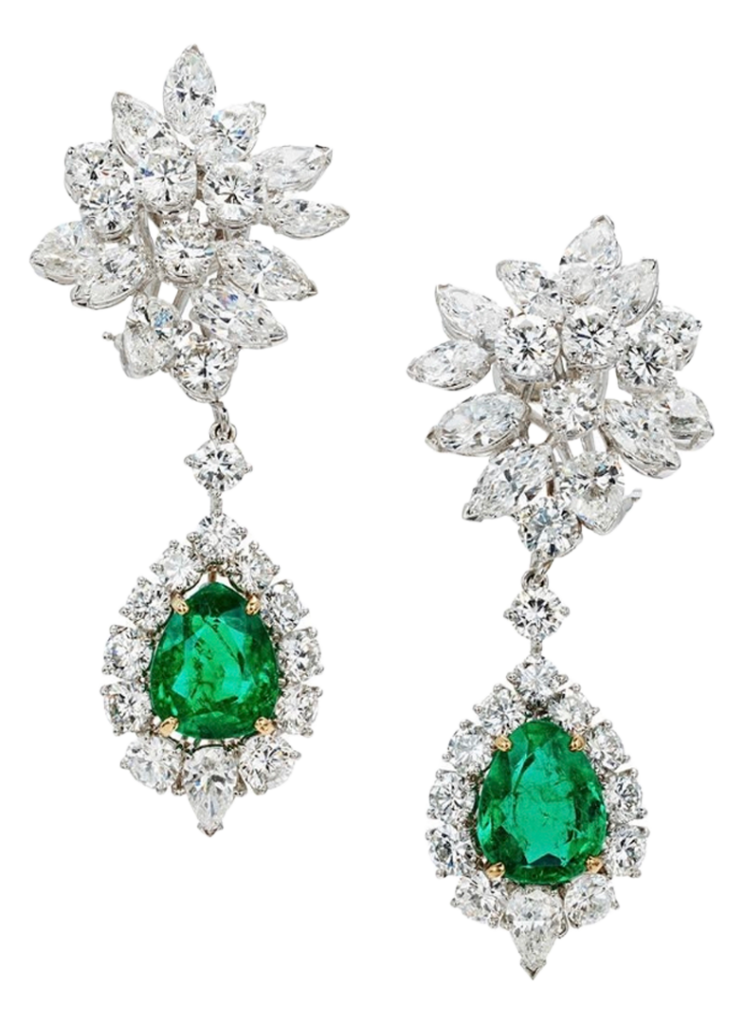Deep in the heart of the mountainous semitropical region of Colombia you’ll find the mines that produce what are considered to be some of the world’s finest emeralds, highly valued for their color, clarity and quality. Since pre-Colombian times emeralds have been used for trade and as offerings in religious ceremonies in South America. Archeologists have determined that the mines have been active for over 1000 years, with indigenous people mining emeralds and then trading them with other people in the region. The Incans used emeralds in jewelry as well as for religious ceremonies and Aztec Emperor Montezuma was known to adorn himself with emeralds.
When the Spanish conquistadors arrived in Colombia in 1499, they were intrigued by the green gem, taking the stones back to Europe where they were a big hit. The conquistadors returned numerous times and in 1537, Gonzalo Juienez de Quesada conquered Colombia and took over the mines. Unfortunately, the indigenous people were enslaved and forced to work in the mines to fill the demand for emeralds that came from Europe, India, Turkey and even Persia. Eventually the mines were returned to the government after Colombia gained partial independence from Spain in 1810 and full independence in 1819.

Muzo, Chivor and Coscuez
While emerald mines can be found scattered around the country, the three most important mining areas in Colombia are Muzo, Chivor and Coscuez.
Located about 65 miles (105 kilometers) North of Bogotá, in the hot, muggy and mountainous jungle filled with gangs and robbers, Muzo is generally considered to be the most important emerald mining area in the world. It is also the oldest mine. It has been worked on again, off again for centuries, earning Muzo the title of “Emerald Capital of the World”. The emeralds that come out of the Muzo mine are admired for their pure green to bluish-green color. The Muzo mines are owned by the government and are leased to various mining companies. The Coscuez mines, which are also owned by the Colombian government, are located just a few miles northeast of Muzo also in hot, muggy rainforest terrain.
The emerald mines in Chivor are the only privately owned mines in Colombia. They are located about 47 miles (75 kilometers) northeast of Bogata, in an area dense with forests and vegetation. This mine is known for producing bluish-green emeralds with good clarity. Emeralds from the Chivor mine are sometimes identified by minute pyrite crystals in the stone. In 1675 the Chivor mine was abandoned and lost to the overgrown terrain. No one could find the mine until a Colombian mining engineer found a 17th century map with directions to the mine. That was in 1888, even with the directions the terrain was so rugged that it was 1896 before the mine was actually found again.

The Elements
Emerald is part of the beryl family of gemstones. It gets its color from trace elements of chromium, vanadium and iron. The presence of these elements will determine if the emerald is blue-green, yellow-green, or the highly prized pure green. The rich green of Colombian emeralds is due to the presence of more chromium than vanadium and the lack of iron. When iron is present, the gem will have a more greenish-blue color.
Le Jardin
One of the unique features of an emerald is its active inner life. Emeralds are filled with inclusions that are part of the natural beauty of the stone. These inclusions can be gas bubbles, or minute minerals within the stone such as calcite or pyrite. There are also tendrils throughout most emeralds that have a viney appearance called the garden or “le jardin” in French. Sometimes if an emerald is too heavily included it will not show the color as well as a less included gem.
Sometimes when an emerald is very heavily included it will be treated with a process that fills the fractures in the stone. There are a number of ways that an emerald may be treated, but oiling the stones is the most common enhancement. The procedure is fairly simple, involving the use of oil applied to the stone’s surface so that it will seep into the surface fractures. Cedar oil is commonly used to oil emeralds, it won’t harm the stone or change its color, but it isn’t permanent. An emerald that is untreated or has minor oil, will be the most valuable, while a stone with significant oil will be less valuable. A gemological report from a reputable gemological laboratory will provide information about the type of treatment that may have been used on an emerald.
From the Incans and Aztecs to European royalty and Indian Maharajahs, Colombian emeralds are widely considered to be some of the world’s finest gems and are highly desired for their glowing green color that sets the standard for emeralds around the globe.
Top of Page: No clarity enhancement 2.10-carat rectangular step-cut Colombian emerald center stone, diamond and platinum pendant, Edwardian, circa 1910, accompanied by an SSEF report, courtesy Hancocks of London (@hancocks_london).
Authored by Amber Michelle


